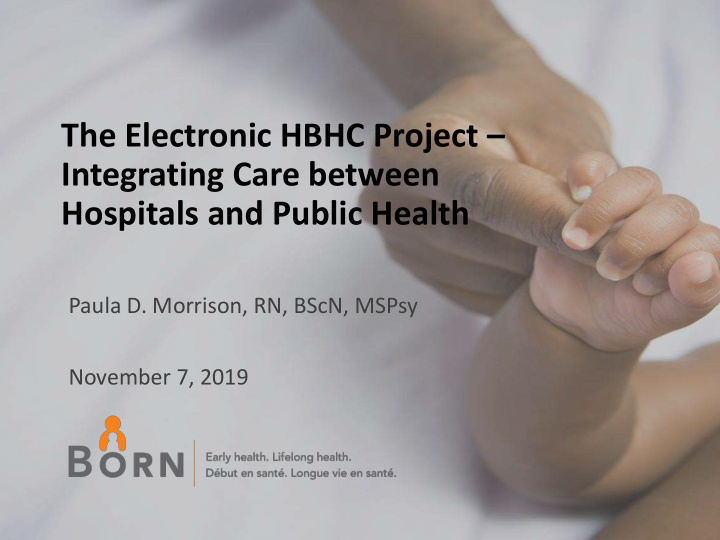



The Electronic HBHC Project – Integrating Care between Hospitals and Public Health Paula D. Morrison, RN, BScN, MSPsy November 7, 2019
Introduction Objectives Outline Processes Results Next Steps
eHBHC partnerships 69 Hospitals CYSS 33 I&IT Public Health Cluster Units Ontario families Midwives supporting MCCSS hospital partners BORN Ontario Dapasoft
Introduction The project was intended to result in the following benefits: • Increased efficiency and ease of HBHC screen completion • Reduced duplication of data entry • Protection of personal health information (PHI) • Reduced number of missed HBHC screens • Faster follow- up with families identified as “with risk”
Objectives 1. Improve outcomes for children and families in Ontario by applying innovative strategies with accurate, complete screening 2. Enhance knowledge of the initiative 3. Understand the use of innovation to provide a standardized mechanisms for universal post partum screening 4. Utilize pre-population and data validation rules to reduce data quality issues 5. Reduce the risk of privacy breaches by eliminating non-secure transfer methods of PHI
Improve outcomes for children and families in Ontario eHBHC is the electronic Healthy Babies Healthy version of the HBHC Children Screening (HBHC) Pilot (2016) and Provincial Roll-out (2018/19) Postpartum: Universally paper screening to be offered on all parents Designed to enhance the way in which HBHC before discharge from hospital screening information moves between hospitals to community public health providers Transferred through fax or manually - higher chance of breach
How postnatal HBHC screening works BIS ISCIS Acronyms BIS = BORN Information System ISCIS =Integrated Services for Children Information System HBHC =Healthy Babies Healthy Children
Electronic HBHC screening BIS-ISCIS Interface • Submission of the HBHC • Decision to accept/ forward screen to the integrated path the HBHC Screen between the BIS and ISCIS is • Verify that the data entered • Based on standardized MCCSS contingent on consent populates the correct data HBHC Screen verification in the BIS points in ISCIS for HBHC • Screens are ONLY sent to the Program response PHU based on consent • Sharing of the information is based on the authority as a HBHC Screen in the prescribed registry Born Information ISCIS System 9
Provincial Rollout 2018/19 33/35 PHUs (94%) eHBHC participation 33 69/96 birthing 27 69 hospitals (72%) 52 13 9 18 9 2016 PILOT JAN-18 DEC-18 JUN-19 Birthing Hospitals Public Health Units
Flexibility in eHBHC HBHC procedural factors • HBHC model – Public Health Nurse (PHN) – Hybrid (Hospital staff & PHN) – Hospital staff • Type of BIS data entry – Manual sites – Upload sites 11
eHBHC Mobilized • Individual sites • Process Mapping • BIS training site • Generalized to all sites – biweekly • eHBHC Encounter during cycles Training Manual • BIS training (BORN) • BIS training videos Training Communication • ISCIS training (MCCSS) Support to Biweekly sites teleconference • eHBHC champions • All sites in cycle • BORN Clinical Lead • BORN eHBHC triaging issues and project team questions • MCCSS • Logging of all issues identified – solutions 12
How eHBHC screening has improved facilitation of care Better Improved Increased Improved privacy data quality efficiencies relationships protection Removed major Patient data bottlenecks in Screens more securely Closer working screening and complete transmitted relationships follow-up electronically between process hospitals and associated PHU – teamwork Consent Easier data entry with new More room for confirmation and process comments before screens transmission are transmitted 14
Missed HBHC Screening • About 20% missed HBHC screens prior to eHBHC (based on study by PHO 2014) – estimate now around 10% overall with 52 participating hospitals in 2018 • Understanding the factors that influence why screens are missed and we can target interventions 15
100% 90% 80% 70% 60% Screens offered 50% Screens not offered 40% 30% Results 20% 10% 0% Jan Feb Mar Apr May Jun Jul Aug Sep Oct Nov Dec Percentage of eHBHC screens not offered & eHBHC screens offered (2018 data - 52 hospitals)
Results • Our analysis shows that factors being associated with missed screens were the following clinical variables • NICU/SCN admissions • maternal postpartum length of stay • neonatal health complications • type of birth • parity HBHC procedural factors showed no statistical significance • HBHC model • type of BIS data entry • weekend/weekday discharge date • no variables were statistically significant
What is the impact of this project? • BORN has helped improve facilitation of care • We are now able to actually match missed screens to the BIS data we can now: • target interventions • Understanding the factors that influence why screens are missed and we can target interventions • Development of eHBHC Screening Rate Report for health units to quantify and understand the magnitude of missed eHBHC screens within their health unit catchment area
eHBHC Completion Rates by PHU Residence ( pseudo data) # of screens Total # births # # not yet by PHU Live Births Stillbirths matched to Organization residence a birth N n n n Hospital Y 716 716 0 25 Parity Parity 1 354 354 0 0 Parity 2 or more 362 362 0 0 Language English 617 617 0 0 French 10 10 0 0 Other language 24 24 0 0 Unknown language 62 62 0 0 Discharge Home with Yes 542 542 0 0 mother No 64 63 0 0 Unknown 110 110 0 0
Next Steps Sustainability Research opportunities • Technical • Missed HBHC screening • technical fixes and improvements • Site support & education • CQI activities – missed screens • Continued support to eHBHC users • Look towards the future opportunities • Expansion of eHBHC • Engage hospitals and health units not participating yet • Explore opportunities with Midwives Teams
QUESTIO IONS • Contact information: pmorrison@BORNOntario.ca
Recommend
More recommend